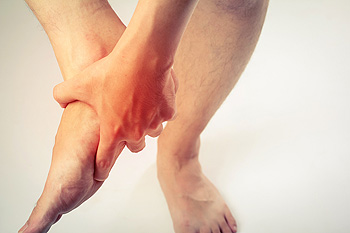Items filtered by date: September 2022
All About Foot Pain

The feet are hard at work every day as they support your weight when you walk, run, and jump. As a result, foot pain is a common occurrence. Sprains, fractures, and inflammation can limit your movements and impede your daily life. With 26 bones and multiple muscles, ligaments, and tendons in each foot, the possibilities for foot pain are numerous. Common causes of foot pain include improper or ill-fitting footwear, exercise or sports-related injuries, osteoarthritis, and rheumatoid arthritis. Diabetes, which can result in nerve and circulation damage, can be a generator of foot pain. Further conditions that cause heel pain are plantar fasciitis and Achilles tendonitis. Foot deformities like bunions and hammertoes cause foot pain. Warts, ingrown toenails, and corns are among the causes, too. Treatment for foot pain depends on the underlying cause. To learn more, please consult a podiatrist who is trained to deal specifically with foot problems and their causes.
Foot Pain
Foot pain can be extremely painful and debilitating. If you have a foot pain, consult with Dr. Michael A. Wood from Foot Health Institute. Our doctor will assess your condition and provide you with quality foot and ankle treatment.
Causes
Foot pain is a very broad condition that could be caused by one or more ailments. The most common include:
- Bunions
- Hammertoes
- Plantar Fasciitis
- Bone Spurs
- Corns
- Tarsal Tunnel Syndrome
- Ingrown Toenails
- Arthritis (such as Gout, Rheumatoid, and Osteoarthritis)
- Flat Feet
- Injury (from stress fractures, broken toe, foot, ankle, Achilles tendon ruptures, and sprains)
- And more
Diagnosis
To figure out the cause of foot pain, podiatrists utilize several different methods. This can range from simple visual inspections and sensation tests to X-rays and MRI scans. Prior medical history, family medical history, and any recent physical traumatic events will all be taken into consideration for a proper diagnosis.
Treatment
Treatment depends upon the cause of the foot pain. Whether it is resting, staying off the foot, or having surgery; podiatrists have a number of treatment options available for foot pain.
If you have any questions, please feel free to contact one of our offices located in Lansing, and Chicago, IL . We offer the newest diagnostic and treatment technologies for all your foot care needs.
Broken Pinky Toe

A broken pinky toe is a fracture of the smallest toe. This can happen from a direct impact, stubbing the toe, or dropping something heavy on it. A broken pinky toe is a common fracture and the break often happens at the toe base. Symptoms of this type of fracture include pain, possible deformity, redness, bruising, and swelling. A snapping, grinding, or popping sound can also occur when a patient breaks their pinky toe, and fever may also develop. Though the discomfort from a broken pinky toe can cause unbearable pain at the time of a break, or when touched, it might not impact the ability to walk. If the toe is broken to the point of developing an open wound, immediate medical treatment must be sought to prevent infection. It is advised that you see a podiatrist if you have broken your pinky toe, and if it is left untreated, complications and chronic problems can arise.
Broken toes may cause a lot of pain and should be treated as soon as possible. If you have any concerns about your feet, contact Dr. Michael A. Wood from Foot Health Institute. Our doctor will treat your foot and ankle needs.
What Is a Broken Toe?
A broken toe occurs when one or more of the toe bones of the foot are broken after an injury. Injuries such as stubbing your toe or dropping a heavy object on it may cause a toe fracture.
Symptoms of a Broken Toe
- Swelling
- Pain (with/without wearing shoes)
- Stiffness
- Nail Injury
Although the injured toe should be monitored daily, it is especially important to have a podiatrist look at your toe if you have severe symptoms. Some of these symptoms include worsening or new pain that is not relieved with medication, sores, redness, or open wounds near the toe.
If you have any questions, please feel free to contact one of our offices located in Lansing, and Chicago, IL . We offer the newest diagnostic and treatment technologies for all your foot care needs.
Ledderhose Disease Is a Type of Plantar Fibromatosis

Patients who have hard or flattened nodules on the bottom of their feet may have a foot condition known as plantar fibromatosis. A specific type of this ailment is referred to as Ledderhose disease and it is a rare foot condition. Patients may notice it affects both feet and typically is painless in the beginning stages. Pain and discomfort may gradually occur while walking and medical attention is often sought from a podiatrist who can treat this condition. There are several reasons why this condition may occur, including genetic history, long-term alcohol use, chronic liver disease, and diabetes. Some of the symptoms that are associated with this condition may be joint pain in other areas of the body and some people may experience a tingling or numbing sensation. If you have small bumps on the bottom of your feet, it is strongly advised that you are under the care of a podiatrist who can effectively diagnose and treat Ledderhose disease.
Some foot conditions may require additional professional care. If you have any concerns, contact Dr. Michael A. Wood of Foot Health Institute. Our doctor can provide the care you need to keep you pain-free and on your feet.
Rare Foot Conditions
The majority of foot conditions are common and can be treated by a podiatrist. Standard diagnostic procedures are generally used to identify specific conditions and treatment can be rendered. A podiatrist also treats rare foot conditions which can be difficult to diagnose and may need extra attention and care.
There are many rare foot conditions that can affect children. Some of these can include:
- Freiberg’s disease
- Kohler’s disease
- Maffucci syndrome
Freiberg’s disease - This can be seen as a deterioration and flattening of a metatarsal bone that exists in the ball of the foot. It typically affects pre-teen and teenage girls, but can affect anyone at any age. Symptoms that can accompany this can be swelling, stiffness, and the patient may limp.
Kohler’s disease - This often targets the bone in the arch of the foot and affects younger boys. It can lead to an interruption of the blood supply which ultimately can lead to bone deterioration. The patient may limp or experience tenderness, swelling, and redness.
Maffucci syndrome - This affects the long bones in a child’s foot leading to the development of abnormal bone lesions. They are benign growths and typically develop in early childhood and the bones may be susceptible to breaking.
A podiatrist can properly diagnose and treat all types of rare foot conditions. If your child is affected by any of these symptoms or conditions, please don’t hesitate to call our office so the correct treatment method can begin.
If you have any questions please feel free to contact one of our offices located in Lansing, and Chicago, IL . We offer the newest diagnostic tools and technology to treat your foot and ankle needs.
Facts About Cuboid Bone Fractures

A stress fracture of the cuboid bone is said to be more common among people who run and play sports like basketball, gymnastics, and ballet. The main symptom of a cuboid stress fracture is continually building pain on the top of the foot near the 4th and 5th metatarsals. A cuboid stress fracture is considered to be a repetitive overuse injury and may be difficult to detect. At first, pain is experienced during or directly after activity, but it often progresses to pain while at rest which is a sure sign of a stress fracture, experts say. This injury may be the result of rapid increases in training distance, duration, or intensity. Other considerations are nutrition, footwear, and medications. A proper diagnosis can be made through imaging tests, such as an MRI. Treatment usually starts with rest, ice, compression, and elevation, but may include wearing a cast or boot. Surgery may be needed in more severe cases. Bone healing typically takes six to ten weeks. For further information, please consult a podiatrist for a proper diagnosis.
Stress fractures occur when there is a tiny crack within a bone. To learn more, contact Dr. Michael A. Wood from Foot Health Institute. Our doctor can provide the care you need to keep you pain free and on your feet.
How Are They Caused?
Stress fractures are the result of repetitive force being placed on the bone. Since the lower leg and feet often carry most of the body’s weight, stress fractures are likely to occur in these areas. If you rush into a new exercise, you are more likely to develop a stress fracture since you are starting too much, too soon. Pain resulting from stress fractures may go unnoticed at first, however it may start to worsen over time.
Risk Factors
- Gender – They are more commonly found in women compared to men.
- Foot Problems – People with unusual arches in their feet are more likely to develop stress fractures.
- Certain Sports – Dancers, gymnasts, tennis players, runners, and basketball players are more likely to develop stress fractures.
- Lack of Nutrients – A lack of vitamin D and calcium may weaken the bones and make you more prone to stress fractures
- Weak Bones – Osteoporosis can weaken the bones therefore resulting in stress fractures
Stress fractures do not always heal properly, so it is important that you seek help from a podiatrist if you suspect you may have one. Ignoring your stress fracture may cause it to worsen, and you may develop chronic pain as well as additional fractures.
If you have any questions, please feel free to contact one of our offices located in Lansing, and Chicago, IL . We offer the newest diagnostic and treatment technologies for all your foot care needs.

